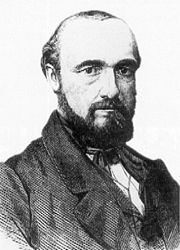
Carl Reinhold August Wunderlich
Encyclopedia

Sulz am Neckar
Sulz am Neckar is a town in the district of Rottweil, in Baden-Württemberg, Germany. It is situated on the river Neckar, 22 km north of Rottweil, and 19 km southeast of Freudenstadt....
– September 25, 1877, Leipzig
Leipzig
Leipzig Leipzig has always been a trade city, situated during the time of the Holy Roman Empire at the intersection of the Via Regia and Via Imperii, two important trade routes. At one time, Leipzig was one of the major European centres of learning and culture in fields such as music and publishing...
) was a German physician
Physician
A physician is a health care provider who practices the profession of medicine, which is concerned with promoting, maintaining or restoring human health through the study, diagnosis, and treatment of disease, injury and other physical and mental impairments...
, pioneer psychiatrist
Psychiatrist
A psychiatrist is a physician who specializes in the diagnosis and treatment of mental disorders. All psychiatrists are trained in diagnostic evaluation and in psychotherapy...
, and medical professor. He is known for his measurement of mean healthy human body temperature
Normal human body temperature
Normal human body temperature, also known as normothermia or euthermia, is a concept that depends upon the place in the body at which the measurement is made, and the time of day and level of activity of the person...
of 37°C (98.6°F), now known more accurately to be about 36.8°C (98.2°F).
He attended grammar school in Stuttgart
Stuttgart
Stuttgart is the capital of the state of Baden-Württemberg in southern Germany. The sixth-largest city in Germany, Stuttgart has a population of 600,038 while the metropolitan area has a population of 5.3 million ....
and at the age of eighteen he began his medical studies at Tübingen University, where he completed his final exams in 1837. In 1838 he worked as assistant at St Catharine's Hospital in Stuttgart, and wrote his MD thesis. Two years later he wrote his MD habilitation
Habilitation
Habilitation is the highest academic qualification a scholar can achieve by his or her own pursuit in several European and Asian countries. Earned after obtaining a research doctorate, such as a PhD, habilitation requires the candidate to write a professorial thesis based on independent...
on internal medicine at Tübingen University
In 1846 he was appointed Professor (ordentlicher Professor) and head of the general hospital at Tübingen. Four years later he moved to Leipzig University as Professor and Medical Director of the university hospital. There he introduced clinical pedagogy, combined with a rigorous methodology of diagnosis, and empirical observation of patients. He introduced temperature charts into hospitals, holding that fever is not a disease, but a symptom. The thermometer he used was reportedly a foot long, and required 20 minutes to register the temperature.
He was known for his lectures on psychiatry and on the "pathology and therapy of illnesses of the nervous system
Nervous system
The nervous system is an organ system containing a network of specialized cells called neurons that coordinate the actions of an animal and transmit signals between different parts of its body. In most animals the nervous system consists of two parts, central and peripheral. The central nervous...
." He described an extremely rare eponymous syndrome which consists of retroperitoneal bleeding from the kidney
Kidney
The kidneys, organs with several functions, serve essential regulatory roles in most animals, including vertebrates and some invertebrates. They are essential in the urinary system and also serve homeostatic functions such as the regulation of electrolytes, maintenance of acid–base balance, and...
which tracks into the surrounding tissues. This may be due to benign or malignant disease. In 1871 he was appointed to the Department of Medicine's organisational commission for the construction and design of psychiatric hospitals.
External links
- Archives for the History of Psychiatry in Leipzig online
- "Carl Reinhold August Wunderlich und die Universitätsklinik St. Jakob", from the History of the University of LeipzigUniversity of LeipzigThe University of Leipzig , located in Leipzig in the Free State of Saxony, Germany, is one of the oldest universities in the world and the second-oldest university in Germany...

